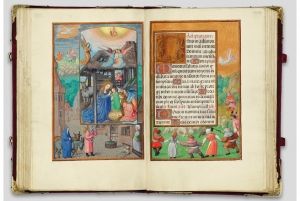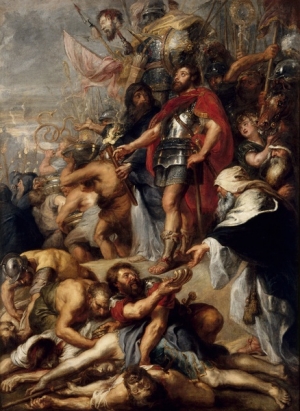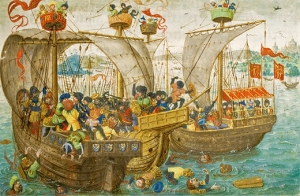|
Displaying items by tag: flemish
The name Pieter Coecke van Aelst, though plenty illustrious-sounding, is not widely known — or at least, according to the curators behind his current exhibition at the Metropolitan Museum of Art, not nearly as well known as it ought to be. A Netherlandish artist-of-all-trades active in the early- to mid-16th century, Coecke was a contemporary of Raphael, supported the fledgling Pieter Bruegel the Elder (who would go on to marry Coecke’s daughter), and was collected competitively by King Henry VIII and Cosimo de Medici, among others. And still, he is often relegated to the annals of art history. The Met’s “Grand Design: Pieter Coecke van Aelst and Renaissance Tapestry,” on view through January 11, 2015, represents his first-ever major solo exhibition.
Of course, part of Coecke’s lesser notoriety may be connected to that of his primary medium.
The Flemish Baroque master Peter Paul Rubens and the beautiful Infanta Isabel Clara Eugenia, the sovereign of the Spanish Netherlands, shared an artistic vision in service of the Catholic faith. In the 1620s, Eugenia commissioned Rubens to create 20 massive tapestries celebrating the Catholic Church through vivid allegorical scenes.
Those tapestries usually are at the Monasterio de las Descalzas Reales (Convent of the Barefoot Royals) in Madrid, where they are rarely seen by the public. But that will change Oct. 14, when they go on view at the J. Paul Getty Museum as part of the exhibition "Spectacular Rubens: The Triumph of the Eucharist."

Christie’s Old Masters Week, which took place in New York from January 28 through January 30, garnered $68 million. The top lot was ‘The Rothschild Prayerbook,’ a masterpiece from the Flemish Renaissance that sold for $13.6 million, a record for an illuminated manuscript at auction.
‘The Rothschild Prayerbook’ is comprised of lavish and intricate illustrations by the most celebrated court artists of the Renaissance, including Gerard Horenbout and Alexander Bening. The book was most likely made around 1505 for someone connected to the imperial court in the Netherlands. Kay Sutton, the Director of Books and Manuscripts at Christie’s, said, “The Rothschild Prayerbook is a fabulous work of art and it has been an enormous pleasure and honour for us to be able to show it so widely and to such universal admiration -- an admiration recognized by the price it achieved at auction.”
Other highlights from Christie’s Old Masters Week included Francisco de Goya’s ‘Los Caprichos’, a set of 80 etchings that sold for $1.4 million; Tiepolo’s ‘I Cani Sapienti,’ which garnered $3.6 million, a record for a single work by the artist at auction; and a drawing by Peter Paul Rubens titled ‘Saint Ildefonso receiving the Chasuble from the Virgin,’ which netted $233,000.
On Tuesday, January 21, France’s Minister of Culture and Communication, Aurélie Filippetti, announced that the country would return three artworks that were looted during World War II to their rightful owners. The works include a 17th century landscape by the Flemish painter Joos de Momper, an 18th century portrait, and an oil on wood Madonna.
The works are among over 2,000 objects that have been held in temporary custody by French museums since the end of World War II. Some critics have spoken out against France, claiming that the country has not been proactive enough in terms of restitution efforts.
Since the end of World War II, France has returned around 80 looted artworks.
A painting featured on the BBC television program ‘Antiques Roadshow’ has been deemed an authentic work by the 17th century Flemish Baroque master, Anthony Van Dyck. The portrait, which was purchased by Father Jamie MacLeod for $660, is estimated to be worth over $660,000.
Fiona Bruce, the host of ‘Antiques Roadshow,’ suspected that the painting was a Van Dyck during taping. After undergoing a cleaning and restoration, the work was authenticated by Van Dyck expert, Christopher Brown.
Father MacLeod plans to sell the painting and will use the profits to buy new bells for his church.

British authorities have lifted the export ban on Raphael’s drawing Head of a Young Apostle. The Old Master work will go to Leon Black, a New York-based billionaire who paid $47.9 million for it at Sotheby’s London in December 2012. The drawing, which was created between 1519 and 1520, was a study for the artist’s revered painting The Transfiguration, which resides in the Vatican’s collection.
The UK’s arts minister Ed Vaizey quickly placed the work under an export ban following the sale, which broke the auction record for a work on paper. The point of the ban was to provide enough time for an interested buyer to raise the money necessary to keep the drawing in the country. The ban expired on July 3, 2013 and was not extended.
Britain has recently employed a number of export bans on culturally significant works. Two pieces, which were purchased by the J. Paul Getty Museum in Los Angeles, are currently being held in the U.K. Officials are waiting to see if any buyers will step forward for a rare 15th century Flemish manuscript titled Roman de Gillion de Trazignes and Rembrandt Laughing, a self-portrait by the Dutch master. The Getty paid $5.8 million and $25 million for the works respectively.
Serbian police recovered Rembrandt’s (1606-1669) Portrait of a Father on Tuesday, March 12, 2013, seven years a after it was stolen from the Novi Sad City Museum located in the northern city of Novi Sad. Police arrested four people in connection to the 2006 heist that involved three other paintings including a work by the Flemish Baroque painter Peter Paul Rubens (1577-1640), a 17th century piece by the Italian Baroque painter Francesco Mola (1612-1666), and another painting from the 16th century by an unknown German-Dutch artist.
Rembrandt, one of the greatest painters and printmakers in European art history, painted Portrait of Father in 1630 and it is estimated to be worth around $3.7 million. The painting was stolen 10 years prior to the 2006 robbery, but it was eventually recovered in Spain.
None of the other works involved in the Serbian heist have been found.

A painting by the 17th century Flemish Baroque artist, Anthony van Dyck (1599-1641), was discovered in a storage room belonging to the Bowes Museum in England. Portrait of Olive Boteler Porter was purchased by the Bowes Museum’s founders, John and Josephine Bowes, in 1866 and has been in the institution’s collection since it opened to the public in 1892.
The painting’s poor condition led museum officials to record it in files as ‘School of van Dyck’ rather than an original van Dyck masterpiece. Relegated to a storage room, the work was discovered when it was photographed earlier this year for a project committed to putting all of the UK’s publically owned oil paintings on a single website. Art historian and dealer, Dr. Bendor Grosvenor, who is working on the digital venture, recognized the wrongly identified painting as an original Van Dyck.
The oil on canvas painting features the expert drapery and coloring often present in van Dyck’s female portraits from the 1630s. Originally thought to be a painting of Queen Henrietta Maria, additional research identified the sitter as Olive Boteler Porter, the queen’s lady-in-waiting and the wife of van Dyck’s friend and patron Endymion Porter.
After being examined by various van Dyck scholars, the painting has been authenticated. The recently restored masterpiece is now on view at the Bowes Museum.

During the French Revolution, which lasted from 1789 to 1799, French troops took Flemish Baroque painter Peter Paul Rubens’ (1577-1640) The Triumph of Judas Maccabeus from the Tournai cathedral in Belgium. The work was whisked away to Paris and in 1801 it was sent to the Musée des Beaux-Arts in Nantes, France.
The Triumph of Judas Maccabeus is one half of a diptych that was commissioned for the cathedral by the bishop of Tournai in 1635. Napoleon’s army stole both The Triumph of Judas Maccabeus and its accompanying work, The Freeing of the Souls from Purgatory, which was returned to the cathedral in 1818.
Tournai officials are adamant about having the Rubens painting returned to the cathedral. Ruby Demotte, president of the French Community of Belgium, has penned a letter to French president Francois Hollande as well as to the French culture minister Aurélie Filippetti asking that the work be sent back to Belgium. Demotte made the same attempt last year but never received a response from the French government.
Tournai recently completed a major renovation of its cathedral and are hoping to finally reunite the two Rubens paintings.

Los Angeles’ J. Paul Getty Museum purchased a Flemish illuminated manuscript at Sotheby’s for $6.2 million on Wednesday, December 5. The Roman de Gillion de Trazegnies by Lieven van Lathem (1430-1493) consists of eight painted half-page miniatures and 44 historiated initials. Lathem is renowned for his paintings of secular scenes during the Flemish high Renaissance of manuscript illumination. The Roman de Gillion de Trazegnies is considered his finest work from the period.
The major acquisition adds to the Getty’s already phenomenal collection of 15th century illuminated manuscripts, which includes Lathem’s only documented manuscript, The Prayer Book of Charles the Bold. Acquired in 1989, Prayer Book serves as the main reference for all other Lathem attributions. The purchase of the Roman de Gillion de Trazegnies joins two of the artist’s defining works in one collection – a remarkable feat.
Roman de Gillion de Trazegnies tells the story of the curious adventures of a nobleman from the family of Trazegnies, whose seat was in Hainaut (present-day Belgium). The tale mixes genres including travelogue, romance, and epic and follows the protagonist, Gillion, on a journey to Egypt, where he comes a bigamist and dies in battle as a hero.
The illumination had been on loan for the Getty’s 2003 landmark exhibition, Illuminating the Renaissance.
|
|
|
|
|